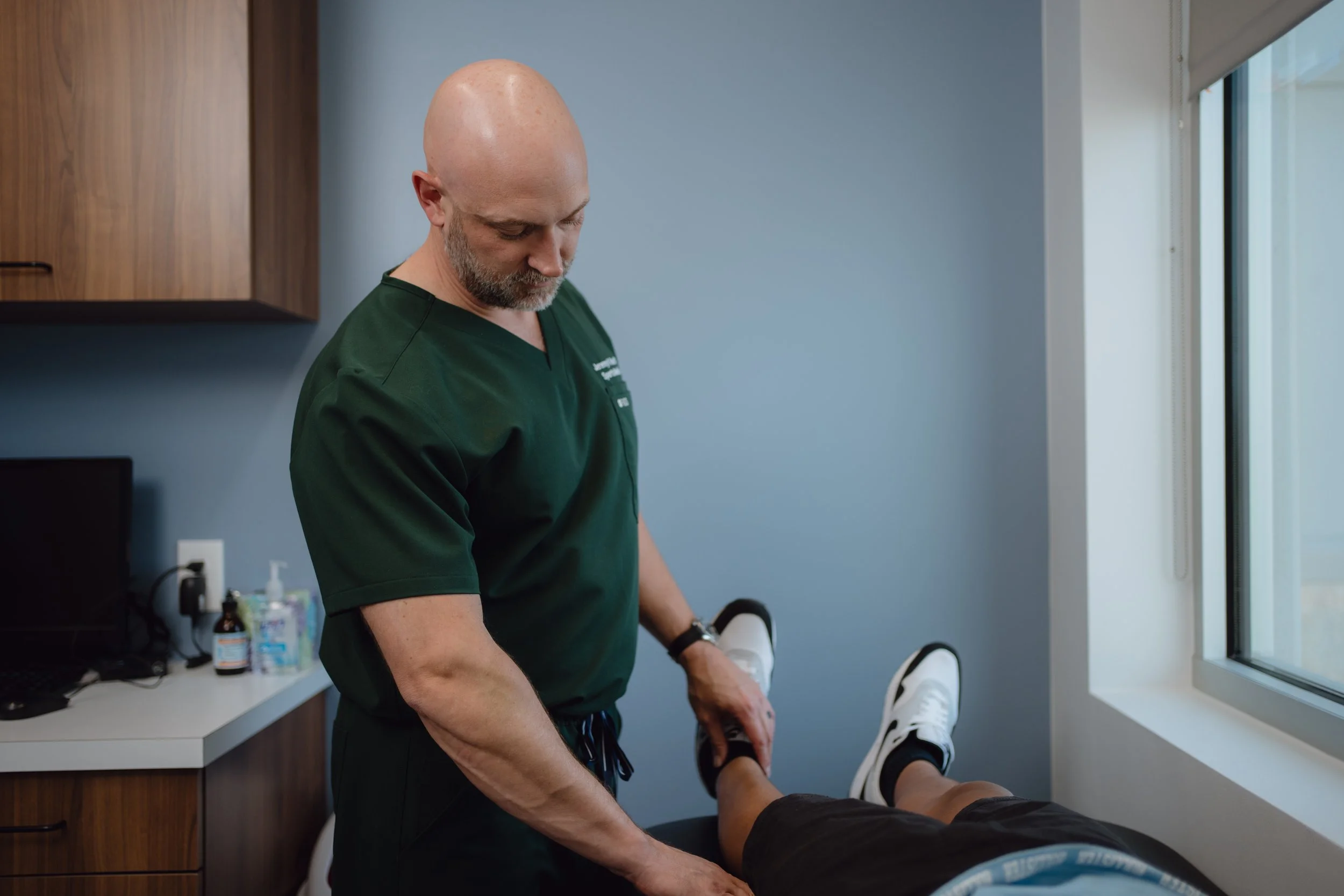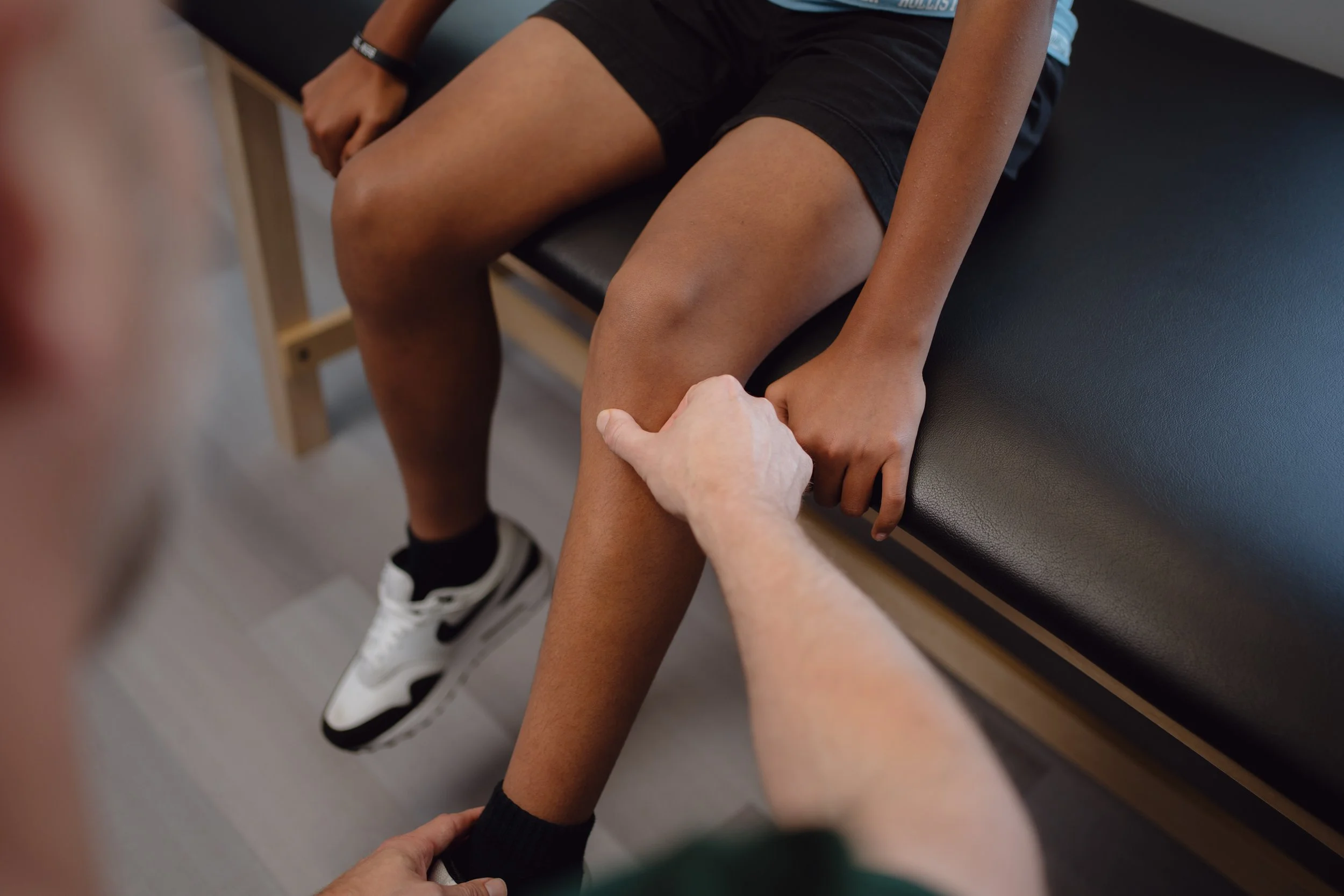
Treatment for Sprains & Strains in San Antonio
Understanding Sprains vs Strains
Athletes frequently experience sprains and strains due to the physical demands of sports, such as running, jumping, pivoting, and sudden directional changes. These injuries can happen in nearly every type of sport, from soccer and basketball to gymnastics and football. While sprains and strains are common, understanding the difference between the two is essential for proper treatment and recovery.
sprains vs strains: What’s the difference?
-
What is a sprain?
A sprain is an injury to the ligaments, the tough bands of tissue that connect bones at a joint. Sprains occur when a ligament is stretched beyond its normal range or torn, often as a result of twisting or impact.
Common sites for sprains include:
Ankles – Rolling or twisting the foot can overstretch the ligaments.
Wrists – A fall on an outstretched hand can strain the ligaments around the joint.
Shoulders – Contact sports or heavy impacts can lead to shoulder sprains.
Sprains vary in severity, from mild (minor stretching of the ligament) to severe (complete tearing). Proper diagnosis and treatment are critical to avoid chronic instability or repeated injuries.
-
What is a strain?
A strain affects muscles or tendons, which connect muscles to bones. Strains often occur when a muscle is overstretched, torn, or experiences excessive force. They are common in high-energy sports and typically affect:
Hamstrings – Sudden sprints or jumps can overstretch the muscles in the back of the thigh.
Groin – Quick lateral movements in sports like soccer or hockey can strain the inner thigh muscles.
Strains also vary in severity, from mild muscle pulls to complete tears. Athletes who attempt to return to play too soon risk re-injury or long-term muscle weakness.
Learn About the Most Common Sprains & Strains in athletes
Sprains
-
Ankle sprains are one of the most common sports injuries, caused by overstretching or tearing of the ligaments around the ankle joint. These injuries range from Grade 1 (mild ligament stretch) to Grade 3 (complete ligament tear).
How It Happens:
Twisting or rolling the ankle during activities like basketball, soccer, or running.
Uneven surfaces or improper footwear can increase the risk.
Prevention Methods:
Use supportive footwear designed for your sport.
Strengthen the ankle with balance exercises like single-leg stands.
Tape or brace the ankle during high-intensity activities, especially after previous injuries.
Suffering from Chronic Ankle Sprains or Instability? Learn More Here
-
Shoulder sprains involve damage to the ligaments in the shoulder joint, commonly caused by falls or impacts. Severity ranges from Grade 1 (mild stretching) to Grade 3 (complete tearing).
How It Happens:
Hard impacts during contact sports like football or wrestling.
Falling on an outstretched arm or shoulder.
Prevention Methods:
Strengthen shoulder and upper body muscles through resistance training.
Practice proper technique in sports to minimize impact risk.An MRI is the next step if an ACL tear is suspected, offering detailed views of the ligament, meniscus, cartilage, and other knee structures.
-
Knee sprains involve injuries to the ligaments within the knee joint, such as the ACL or MCL. These range from mild (Grade 1) to severe (Grade 3) injuries.
How It Happens:
Twisting or pivoting motions in sports like soccer, basketball, or skiing.
Sudden impacts or awkward landings.
Prevention Methods:
Strengthen the muscles around the knee with exercises like squats and leg presses.
Use proper techniques for jumping and landing.
Wear supportive braces or taping if you have a history of knee injuries.
-
Wrist sprains are caused by overstretching or tearing the ligaments in the wrist, often during a fall or impact. These injuries range from Grade 1 (mild stretching) to Grade 3 (complete tear).
How It Happens:
Falling on an outstretched hand in sports like gymnastics, skateboarding, or snowboarding.
Excessive force applied to the wrist during high-intensity movements.
Prevention Methods:
Wear wrist guards during high-risk activities.
Strengthen the wrist and forearm muscles with resistance exercises.
Practice safe landing techniques to reduce fall impact.
-
Elbow sprains occur when the ligaments in the elbow joint are overstretched or torn. These injuries range from Grade 1 (mild stretching) to Grade 3 (complete tear).
How It Happens:
Overuse in sports like baseball, tennis, or gymnastics.
Direct trauma or forceful hyperextension of the elbow.
Prevention Methods:
Practice proper throwing or hitting techniques.
Strengthen arm muscles to stabilize the elbow joint.
Rest adequately to prevent overuse injuries.
Strains
-
Hamstring strains occur when the muscles in the back of the thigh are overstretched or torn. These injuries often range from Grade 1 (mild stretch) to Grade 3 (complete tear).
How It Happens:
Sudden acceleration or deceleration during sports like soccer, basketball, or track.
Poor flexibility or improper warm-ups before physical activity.
Prevention Methods:
Regular stretching to improve flexibility.
Strength training to stabilize the hamstring muscles.
Proper warm-ups before games or workouts.
-
Groin strains affect the muscles of the inner thigh, typically ranging from mild (Grade 1) to severe (Grade 3).
How It Happens:
Quick side-to-side movements or sudden changes in direction, common in soccer, hockey, and tennis.
Overstretching during intense activity.
Prevention Methods:
Perform dynamic stretches targeting the inner thigh.
Avoid overtraining and incorporate rest days.
-
Calf strains affect the muscles in the back of the lower leg, often caused by overstretching or sudden force. These injuries range from Grade 1 (mild muscle stretch) to Grade 3 (complete muscle tear).
How It Happens:
Sudden pushing off during activities like sprinting, tennis, or basketball.
Overuse or fatigue, especially in athletes who train intensely without sufficient rest.
Prevention Methods:
Stretch the calf muscles regularly with exercises like heel drops and wall stretches.
Gradually increase training intensity to avoid overuse.
Wear proper footwear to support your arch and reduce strain.
-
Quadriceps strains involve the muscles in the front of the thigh and typically result from excessive force or overstretching. Severity ranges from mild discomfort to severe tears.
How It Happens:
Explosive movements like sprinting, jumping, or kicking in sports like soccer or basketball.
Inadequate warm-ups or poor flexibility in the quadriceps.
Prevention Methods:
Perform dynamic stretches and warm-ups targeting the thighs before activity.
Strengthen the quads with exercises like lunges and leg presses.
Avoid overtraining by balancing intense workouts with recovery days.
-
Lower back strains occur when the muscles or tendons in the lumbar region are overstretched or torn, often from improper movement or overuse.
How It Happens:
Lifting heavy weights with poor form during strength training.
Twisting or sudden jerking motions in sports like gymnastics or golf.
Prevention Methods:
Strengthen core muscles to support the lower back.
Practice proper form when lifting or bending.
Incorporate flexibility exercises like yoga or pilates into your routine.
Treatment Options for Sprains & Strains
-
The R.I.C.E. Method
The R.I.C.E. method (Rest, Ice, Compression, and Elevation) is a cornerstone of initial treatment for both sprains and strains. This method is most effective within the first 48 hours after injury.
Rest: Avoid activities that put stress on the injured area.
Ice: Apply ice packs for 15-20 minutes every 2-3 hours to reduce swelling and pain.
Compression: Use an elastic bandage to provide support and minimize swelling.
Elevation: Keep the injured area raised above heart level to reduce inflammation.
-
Advanced Treatment Options
For more serious injuries (Grade 2 or 3 sprains/strains), advanced treatments may be required:
Injection Therapy: Platelet-Rich Plasma (PRP) injections or corticosteroids can promote healing and reduce inflammation.
Surgical Intervention: In cases of complete tears or chronic instability, surgery may be needed to repair ligaments, tendons, or muscles.
-
Physical Therapy and Rehabilitation
Rehabilitation is crucial for regaining strength, flexibility, and range of motion:
A physical therapist can create a customized exercise program tailored to the specific injury.
Exercises may include stretching, strengthening, and balance training to prevent future injuries.
-
Pain Management
Over-the-counter medications like ibuprofen or acetaminophen can help reduce pain and inflammation. For more severe cases, your doctor may prescribe anti-inflammatory medications or recommend other interventions.
-
Bracing or Splinting
For moderate to severe injuries, braces, splints, or compression wraps may be used to stabilize the joint or muscle, allowing it to heal properly.
-
Rest and Recovery
Taking adequate time to heal is critical for avoiding re-injury:
- Athletes should follow their doctor’s advice on when to return to sports.
- Progressive reintroduction of activity, starting with low-impact exercises, ensures a safe recovery.
Why Proper Treatment Matters
Untreated or poorly managed sprains and strains can lead to serious long-term complications, such as chronic pain, instability, or recurring injuries. For young athletes, this is particularly concerning as their bodies are still growing, making them more prone to lasting damage.
Proper treatment ensures a safe recovery, allowing athletes to regain their strength, flexibility, and confidence. Dr. Rush provides tailored care for sprains and strains, offering everything from non-surgical therapies to advanced procedures when necessary.
FAQs about sprains & Strains
-
While both injuries may cause pain, swelling, and limited mobility, they have distinct symptoms:
Sprains: Often involve bruising and instability around a joint.
Strains: May include muscle spasms or weakness in the affected area.
If you're unsure, it’s best to consult a specialist for a proper diagnosis.
-
Recovery time depends on the severity:
Mild (Grade 1): 1-2 weeks with rest and basic care.
Moderate (Grade 2): 3-6 weeks, possibly requiring physical therapy.
Severe (Grade 3): 8-12 weeks or longer, and may need surgery.
A healthcare provider can give a more accurate timeline based on your injury.
-
Yes, you should see a doctor if:
The pain is severe or doesn’t improve with rest.
There’s significant swelling or bruising.
You can’t move the joint or bear weight.
The injury causes numbness or tingling.
-
Yes! Here are some tips to reduce your risk:
Warm up before exercise to prepare your muscles and joints.
Strengthen muscles with regular resistance training.
Wear appropriate footwear and protective gear for your activity.
Practice proper techniques in sports and avoid overtraining.
-
Severe injuries (Grade 2 or 3) may require:
Bracing or immobilization to support healing.
Physical therapy to regain strength and flexibility.
In some cases, surgical repair for complete ligament or muscle tears.
Your doctor will recommend a treatment plan tailored to your injury.
-
It’s not recommended to continue playing sports until you’ve fully recovered, as this can worsen the injury or lead to chronic issues. A specialist can guide you on when it’s safe to return to physical activity.
-
Signs of healing include reduced pain, decreased swelling, improved range of motion, and regained strength. If symptoms persist or worsen, consult your doctor to ensure there are no complications.
-
Yes, sprains and strains can become chronic if not properly treated or if the injured area is repeatedly stressed before it has fully healed. Chronic issues may include:
Sprains: Persistent joint instability, weakness, or recurring injuries (e.g., chronic ankle instability).
Strains: Lingering muscle weakness, stiffness, or recurring pain during activity.
Proper rehabilitation and following your doctor’s advice are key to preventing long-term problems.

Meet Your Sprain & Strain Treatment Expert, Dr. Rush
Dr. Jeremy K. Rush, MD, FAAP, is San Antonio's only orthopedic surgeon who is Dual-Fellowship Trained in pediatric orthopedic surgery and sports medicine. He specializes in arthroscopic surgery of the knee, shoulder, elbow, and ankle, as well as the treatment of fractures and other injuries in young athletes.



